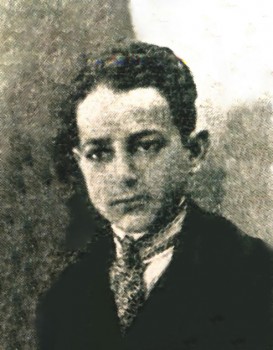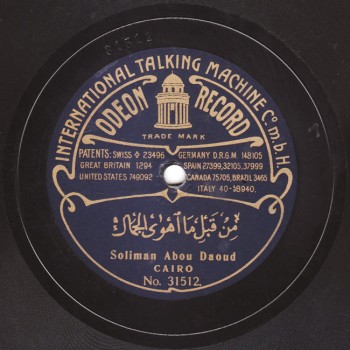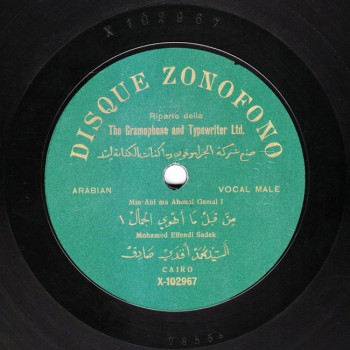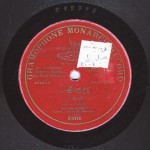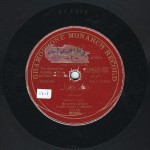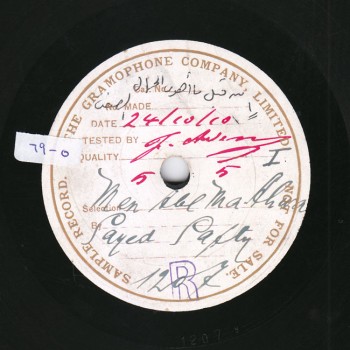 The Arab Music Archiving and Research foundation (AMAR), in collaboration with the Sharjah Art Foundation (SAF), presents “Sama‘ ”.
The Arab Music Archiving and Research foundation (AMAR), in collaboration with the Sharjah Art Foundation (SAF), presents “Sama‘ ”.
“Sama‘ ” discusses our musical heritage through comparison and analysis…
A concept by Mustafa Said.
Dear listeners,
Welcome to a new episode of “Sama‘ ”.
Today’s episode about dawr al-mu‘āraḍa is dedicated to dawr “Min abli mā ahwa el-gamāl”.
In our previous episode, the analysis focused on two dawr: Ibrāhīm al-Qabbānī’s “Min abli mā ahwa el-gamāl” and Dāwūd Ḥusnī’s “Kull mīn yi‘sha’ gamīl”, and the episode ended with Sheikh Yūsuf al-Manyalāwī’s 1908 Gramophone recording of “Min abli mā ahwa el-gamāl” in full, with takht Muḥammad Afandī al-‘Aqqād (qānūn), Ibrāhīm Afandī Sahlūn (kamān), ‘Alī ‘Abduh Ṣāliḥ (nāy), Muḥammad Abū Kāmil al-raqqāq (percussions), ‘Alī Afandī ‘Abd al-Bārī, and Sheikh Yūsuf’s son Ḥasan Yūsuf al-Manyalāwī, added to others in the biṭāna.
We all have an idea now about the dawr and its pattern.
Let us begin our analysis starting from the madhhab:
Sheikh Yūsuf’s madhhab –that we listened to– is quite different from the madhhab’s interpretation by all the other performers.
Let us listen to the madhhab in the oldest recording in our possession, performed by Sī ‘Abduh al-Ḥāmūlī …
(♩)
Here are Aḥmad Farīd, Sulaymān Abū Dāwūd, and Sayyid al-Ṣaftī on the same evening …
(♩)
Alright …
There is a slight difference in Muḥammad Ṣādiq’s interpretation …
(♩)
Let us listen to the two recordings of Sheikh Yūsuf al-Manyalāwī …
(♩)
There is a significant difference!
The director –unknown to me– of Sitt Rawḥiyya Aḥmad’s recording made at least fifty years after Yūsuf al-Manyalāwī’s was influenced by Sheikh Yūsuf al-Manyalāwī’s disc …
(♩)
Note that we are still at the first sentence of the madhhab. It is followed by the tafrīd sentence that most performers agree on.
Let us listen to it in the voice of Sheikh Yūsuf …
(♩)
And now in the voice of Sulaymān Abū Dāwūd who recorded it before Sheikh Yūsuf …
(♩)
Now in the voice of Sitt Rawḥiyya Aḥmad with the lāzima put by the dawr’s director whom, if he were alive, I would ask about the moral or the reason for putting these lāzima and musical introductions in dawr, knowing that they are totally unrelated to the dūlāb that the instrumentalists used to play, or the lāzima, the tarjama (translation or interpretation), that allowed an interaction between the performers, added liveliness among the musicians as well as between the performers and the audience. I honestly do not know what is the moral or logic behind the musical introductions and the fixed lāzima in the middle …
(♩)
This sentence is supposed to be followed by the waḥāyid, i.e. the dialogue between the individual performer and the biṭāna. Let us listen …
(♩)
There is an almost direct shift from/to or a direct relation between the tafrīd and the waḥāyid. The only exception is the interpretation of Aḥmad Farīd who decided to sing āhāt before entering the tarannum, before entering the dawr’s waḥāyid. He even used the sentence of the dawr’s conclusion “El-‘ish’i dah mā lūsh dawā, yiṣabbaḥ el-mughram saqīm” …or “sa’īm” –we will discuss this point later. So he decided to sing āhāt before entering the dialogue with the group …
(♩)
Before we analyse the dialogue, note this rare occurrence: the same band played the dawr twice, once with Sulaymān Abū Dāwūd around 1904, and once with Aḥmad Farīd around 1906 –the Odeon recordings do not give a precise date, at least not in this early period. The band is Takht Odeon with Ḥāj Sayyid al-Suwaysī (‘ūd), ‘Abd al-‘Azīz al-Qabbānī (qānūn), and ‘Alī ‘Abduh Ṣāliḥ (nāy).
Let us assess the band’s mood in the dūlāb and in one or two other sections in the recordings of both Sulaymān Abū Dāwūd and Aḥmad Farīd… Note that their performance in the recording of Sulaymān Abū Dāwūd is much livelier than in Aḥmad Farīd’s recording…
(♩)
Indeed!
Is it because Sulaymān Abū Dāwūd was more famous, at the time, than débutant Aḥmad Farīd, or because his performance of dawr is more joyful? He was indeed joyful, like Sheikh Salāma Ḥigāzī… not dramatic at all. His performance of dawr is cheerful indeed.
Since we are talking about Sulaymān Abū Dāwūd, let us listen to his full performance of the dawr.
We will analyse the waḥāyid after that and focus on first grade ‘ūdist Sayyid al-Suwaysī –“lost by his people”– who has a few recordings, and who is said to be one of the most remarkable ‘ūdists. He brought a lot to ‘ūd playing, was beneficial to those who came after him, and influenced a few musicians including al-Qaṣṣabgī who seems to prolong Ḥāj Sayyid al-Suwaysī’s path –we will get back to the relationship between Ḥāj Sayyid al-Suwaysī and Muḥammad al-Qaṣṣabgī.
Now let us listen to the dawr in the voice of Sulaymān Abū Dāwūd. We will discuss the waḥāyid later …
(♩)
There is supposed to be three hank: the first one is to the bayyātī …
(♩)
The second one is to the jahārkāh, i.e. the bayyātī’s third …
(♩)
The third one is to the ḥijāz, i.e the bayyātī’s fourth. Note that when he performs tafrīd on it, he does it to the shūrī …
(♩)
Why does he, in many cases, perform tafrīd to the jahārkāh at the shūrī? Here is Sheikh Yūsuf al-Manyalāwī for example …
(♩)
It may be a question of mood in Sheikh Yūsuf’s interpretation… But then what about Rawḥiyya Aḥmad who did the same thing? Is it because the person who directed her dawr had only listened to Sheikh Yūsuf’s disc …
(♩)
Now that we have listened to them separately, let us check out Ibrāhīm al-Qabbānī’s perspective on the progression/ascension of the waḥāyid …
(♩)
This was Ibrāhīm al-Qabbānī’s perspective.
The dawr is not free of āhāt: there are some in the end, before “El-‘ish’i dah mā lūsh dawā”, before the conclusion, i.e. the āhāt of the ṣayḥa.
Now, in his 1910 Gramophone recording, Sheikh Sayyid al-Ṣaftī has a different perspective on the ṣayḥa that he extended a little. Maybe this is why the recording was not published… Ibrāhīm al-Qabbānī may have not liked it… We do not know…
Let us listen to Sayyid al-Ṣaftī’s āhāt in this test recording …
(♩)
“El-‘ish’i dah mā lūsh dawā” interpreted by Sheikh Yūsuf …
(♩)
Now here is Sitt Rawḥiyya Aḥmad with her biṭāna…
(♩)
An extremely “calm” interpretation…
Ibrāhīm al-Qabbānī has another perspective on the qafla…
(♩)
Ibrāhīm al-Qabbānī’s perspective is totally different from Sheikh Yūsuf al-Manyalāwī’s. He had surely heard Sheikh Yūsuf and agreed completely with the latter’s qafla which he may have even sung himself… Sheikh Yūsuf al-Manyalāwī is the only one who says “El-‘ish’i dah mā lūsh dawā, yiṣabbaḥ el-mughram saqīm”… all the others say “sa’īm”… which reminds me of what happened a few days ago while we were cleaning the recordings in preparation of this episode: I was with Mr. Usāma ‘Abd al-Fattāḥ who told me “Sa’īla sa’īm” (“sa’īm” does not sound pleasant). Indeed, colloquial Arabic is not always the best choice: “saqīm” sounds beautiful whether the interpretation is in colloquial Arabic or in literary Arabic, the “q” must not necessarily become a “ ’ ”. So Sheikh Yūsuf al-Manyalāwī did indeed choose the best pronunciation: “saqīm” is better than the “sa’īm” pronounced by all the others. This is only a point a view…
We conclude today’s episode with a recording of the dawr by Muḥammad Ṣādiq who made many cylinder recordings before recording discs during Zonophone’s 1905 campaign. The recording was made by Zonophone / Gramophone on two sides of a 25cm record. Ṣādiq is accompanied by Iliās Mshāṭī (violin) and Maqṣūd Kalkajian (qānūn).
(♩)
We will meet again in a new episode to resume our discussion about dawr al-mu‘āraḍa or dawr al-naẓīr
Our next episode will be about dawr “Kull mīn yi‘sha’ gamīl”.
Let us now listen to Muḥammad Ṣādiq.
“Sama‘ ” was presented to you by AMAR.
- 221 – Zakariyya Ahmed – 12 (1/9/2022)
- 220 – Zakariyya Ahmed – 11 (1/9/2022)
- 219 – Zakariyya Ahmed – 10 (11/25/2021)
- 218 – Zakariyya Ahmed – 9 (10/26/2021)
- 217 – Zakariyya Ahmed – 8 (9/24/2021)
- 216 – Zakariyya Ahmed – 7 (9/4/2021)
- 215 – Zakariyya Ahmed – 6 (8/28/2021)
- 214 – Zakariyya Ahmed – 5 (8/6/2021)
- 213 – Zakariyya Ahmed – 4 (6/26/2021)
- 212 – Zakariyya Ahmed – 3 (5/27/2021)
- 211 – Zakariyya Ahmed – 2 (5/1/2021)
- 210 – Zakariyya Ahmed – 1 (4/28/2021)
- 209 – W-al-Lāhi lā astaṭī‘u ṣaddak 2 (4/6/2017)
- 208 – W-al-Lāhi lā astaṭī‘u ṣaddak 1 (3/30/2017)
- 207 – Bashraf qarah baṭāq 7 (3/23/2017)

